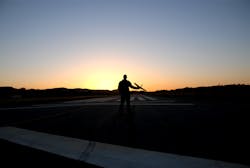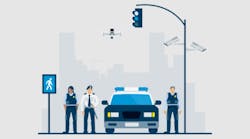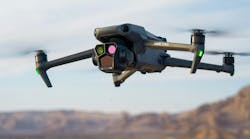The concept of using an unmanned aircraft system (UAS) in law enforcement is not new – the National Institute of Justice even includes the technology within its Aviation Technology Program.
A common public miss-conception of these systems stems from footage of and from the military’s well-known use of the Predator aircraft. Ideas of this slender eye-in-the-sky patrolling the national airspace can be enough to ignite debates of big brother. Ultimately while the Predator is unmanned its use is not very practical for use in law enforcement within the domestic airspace. Perhaps “hand-launched” should precede the acronym, will that help launch the picture we’re talking about here?
These small unmanned systems received their well-known debut in Operation Desert Storm, 1991, and more recently in Afghanistan to help fight the war on terror. This history shows the benefit in cost of operations, enhanced safety in literally removing an airborne pilot out of the equation and the ability of persistence – decreasing the dangers of pilot fatigue while technically being able to remain "in the air" for longer periods of time.
Another well-known example of these types of aircraft in operation are the surveillance footage of the Japaneese Fukushima plant - a good illustration of how UASs can benefit first responders in dangerous enviornments.
The question of how can law enforcement utilize this technology in the national airspace (NAS) is where things get tricky.
High-flying ideas
There are two common categories for law enforcement's mechanical aerial vehicles: rotary wing (helicopter) and fixed wing (airplane). Unmanned vehicles are no different. These unmanned aerieal vehicles (UAVs) are controlled by a pilot or, simly put, controller.
The controller and vehicle commonly communicate via radio frequency through a remote control. Other technologies typically used are cameras, video transmitter/receiver, autopilot systems, altimeter, accelerometers, magnetometers, GPS technologies, gyroscopes, radio frequency or IP communication technologies and the vehicle's battery. With these systems integrated, the computer mostly keeps the vehicle in the air while the controlling device simply directs it. Some systems include a screen for the "pilot" to view the surveillance feed from the aircraft.
With these array of sensors acting as the flight control system, "[technically] you don't need a pilot, the system can take off and can fly in a couple of different methods ... no pilot is necessary to be in that loop," says Dennis D'Annunzio, Rotomotion's cheif operating officer.
But this is academic, cameras have already logged hundreds if not thousands of flight-hours in the air - the advancements in and manipulation of these technologies are the new development. Steve Gitlin, vice president, marketing strategy and communications of AeroVironment, Inc. compares the systems to the evolution of information technology. From the large mainframe computer to home personal computer and eventually an our smartphones in our pocket.
The size drasitically changed, but on a extreme basic level it's still information processing.
"As far as the technology, we're not reinventing anything here," says Benjamin Miller, UAS operations manager from Mesa County (Colo.) Sheriff's Office. Flying helicopters and cameras for observation purposes for search and rescue, surveillance or traffic control has been done for decades. "What we're doing here is making it significantly more affordable," he says. Through his experience Miller suggests a UAS should be $50,000 or less.
In his experience, Kevin Lausher of Draganfly Innovations, Inc. police and military sales, has seen law enforcement use the Draganfly aircraft line mostly for assitance to forensics, investigations and traffic accident and reconstruction. Police can get overall pictures of the accident where agencies have traditionally had used cherry pickers or firetrucks to get the necessary vantage point, he says.
He sees the vehicles have use in search and rescue as well as tactical situations. "[UAVs] are great for doing a reconnaissance of a subject area, they can give you a good overall view of your scene, the physical outline of the building, where windows, doors, escape routes and entry areas," says Lausher.
Gitlin agrees, "We see significant potential for this class of technology to help law enforcement in very important ways that ultimately means saving dollars and saving lives." Earlier this year, he mentions the Texas Department of Public Safety had used a AeroVironment's Wasp system in a hostage situation to get that situational awareness.
Speaking on rotary-wing type of systems, "You may even have hand-launched systems where as for us we just set it out and stand off and it just goes straight up vertically. You can even use it where you can just go straight up and use it like a portable tower," says D'Annunzio.
Miller calls it DQD, decision quality data: "If the people watching the video and looking at the pictures ... can't make a decision based on the data you're giving them you're wasting your time," he says.
However officers do have to realize what they are looking at. Adelman explains that the unmanned aircraft can only show what it can show: "For example, if the officers asked 'Is that Jon?' and you can't tell the face, all you can tell them is it's a male and he looks to be 6 feet tall. [In this example] you wouldn't be able to say 'Yes, I can confirm that's him'."
"The technology is mature, what it can provide is real - it's not something that says 'I think we can do this'," says Miller.
Privacy
As mature as today's technology may be, media always finds a way to address the issue of cilivian privacy almost as if they expect departments to float surveillance above private homes watching them sleep and eat. Older than the UAV technology, this argument is as mature as the grandfathers of its writers.
D'Annunzio refuts these claims by keeping in mind that all aircraft are the just that, aircraft. "[Police] already have aircraft flying ... in the end, just a different way," he says.
The concept of city-wide surveillance have already been in progress. This surveillance keeps an eye on public areas, the warrant system was developed to handle the situations when that eye gazes into private space. Lausher explains that the same rules would apply for law enforcement gaining access in other situations.
"There's nothing new with unmanned aircraft systems in terms of getting evidence and using it, says Adelman, there are already laws established for that. "You wouldn't use [unmanned systems] for the highways or patrol the neighborhoods just for looking around. I think the public perception really needs to be conveyed better by agencies using [unmanned systems]," he says.
Keep it in sight
The privacy issue only exists once the UAV launches, there are different issues at hand for department interested in purchasing, and it starts by working with the FAA.
Because an umanned aircraft flies without a physical pilot within the cockpit - instead the array of sensors populating the UAS flight control system - the FAA claims a controller cannot maintain the See and Avoid requirement of Part 91, Rule 113. Basically, explains says Benjamin Miller, operations manager from Mesa County (Colo.) Sheriff's Office., See and Avoid says that at anytime anyone is flying they at all times must be sure they are not on a collision course with other aircraft and ensuring others are not with them.
"Unmanned aircraft systems don't have a civil airway certificate, they are not like a CESNA airplane, but they still have to abide by the aircraft rules the FAA has," says Tim Adelman, aviation project manager for the Sheriff's Association of Texas and aviation attorney. However, a law enforcement agency is a public entity - public aircraft do not require an airways certificate.
Adelman offers his insight: "A law enforcement agency operating aircraft for its purpose is basically exampt from the civil airmen and airway administration requirement. [However] the FAA has taken the position that to legally fly these things and to comply, you have to get a certificate of authorization (COA) from the FAA that can only be given to a public entity."
In the past, he adds, public entities have incorrecty assumed that they could use UAVs using an FAA advisory circular regarding the authority of a hobbyist - i.e. a father and son in a park. "A law enforcement agency is not a hobbyist; they are not a recreational user," says Adelman.
What it takes
The technology makes it available so an officer could fly a UAV, recieve the necessary situational awareness to accomplish the mission at hand. Yet, regulations hold the controller to a requirement saying they must be able keep the vehicle within line of sight through the COA, only provided to a public entity. How should law enforcement even begin this process?
Adelman suggests agencies to hire someone familiar with the regulations, someone who can look at the airspace and the mission and help set a plan. This will evetually lead to the creation of a risk management process for operating UASs.
Leonard Ligon, UAS-PSST (Unmanned Aircraft Systems - Public Safety Solutions Team) vice president agrees. "Allow an objective team to come in and look at your system, what it's going to do what the owner says its going to do and it's going to do what you need it do do for your mission," he says. He has worked with a number of universities around the country in helping law enforcement agencies recieve their COAs: University of Alaska, the University of Kansas, the University of North Dakota and New Mexico State University. UAS-PSST was designed to leap-frog off of legal platforms and help public safety agencies develop a unmanned program of their own.
The manufacturer has also traditionally assisted agencies in these matters. However one concern over this, due to the restrictions and regulations for law enforcement UAVs, relevant experience can be tough to find. "A lot of them are DOD-focused and so they don't have the domestic airspace expertise that's necessary," says Adelmen.
As an end-user Miller knows the trials it can take to arrive to a sucessful destination. "My advice to agencies would be to contact the unmanned aircraft programs office inside the FAA ... and walk right through the front door," he says.
The NIJ Aviation Technology Program can be found at www.justnet.org/pages/aviation_aircraft.aspx. The FAA Unmanned Aircraft Program Office (UAPO) can be found through www.faa.org.



